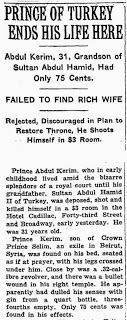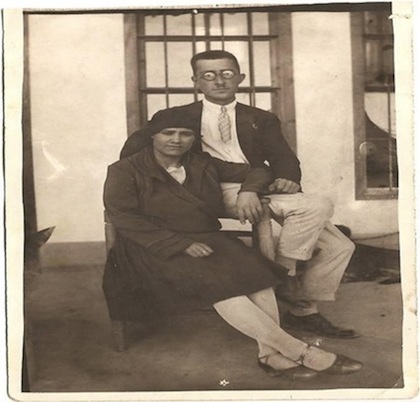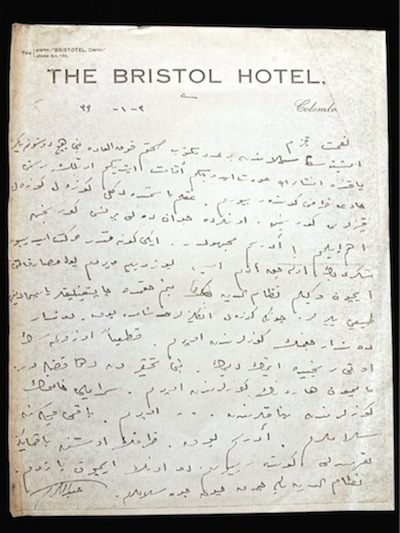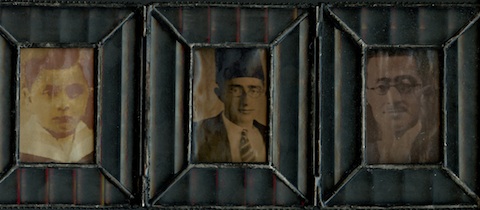The Prince Who Was Killed in a New York Hotel

New York Times article about Prince Abdulkerim's death.
The New York Times claimed the Prince had met Ms. De Stefano while he was staying at the house of a woman by the name of Kadire. The woman’s father had a plumbing store on Stebbins Avenue in the Bronx, near Ms. Kadire’s house.
It is interesting that the Prince would have allegedly written a letter such as this neither to his father Prince Mehmet Selim, who was living in Beirut, nor to his cousin Prince Mehmed Orhan, who was in New York, nor to his friend Şah Mir, who had been the Consul General in New York for 20 years during the Ottoman rule, but to Sergeant Valentin of the New York Police Department. And he had written the letter in Turkish! Detective Robert Rehman from the 47th Street Precinct arranged for a “verbal” translation of this letter to Sergeant Valentine to be made at the Turkish Consulate. That is how the media got to know the content of the letter.

HIH Prince Abdulkerim with his wife Nimet Hanimefendi.
Prince Abdülkerim had come to the hotel at around 12:30 after midnight, and allegedly sent a messenger to the Bronx at 2 a.m. to the woman he loved, to inform her that he would kill himself. At the same time, he had also told the receptionist that he wanted to be woken up at 5 in the morning. When the clerk then knocked on his door at 5 a.m. to wake him and there was no answer, the hotel staff had the door opened. The Prince was found on his bed in a sitting position with his feet tucked under him, and a 32-caliber bullet hole in his head.
In 1935, contact between Ottoman dynasty members and members of the Turkish government or consular staff was strictly forbidden. Hence, the lawyer Dudley Koster, who had worked at the Ottoman consulate prior to the foundation of the Turkish Republic, took charge of the funeral procedures. Prince Abdülkerim’s father had sent a telegraph to the lawyer requesting that they spare no expense to send the body to Beirut. It is also interesting that Koster had announced a few hours after the suicide that Prince Abdülkerim had just received a letter from the Ford Motor Company offering him the position of ‘the Shanghai and Chinese Turkistan representative.’ TURKOFAMERICA researched whether the Ford Motor Company had a copy of such letter; no such record, however, was found.
Prince Abdülkerim’s funeral prayer was carried out with the attendance of few people in a church on 155 Court Street, Brooklyn, with an Islamic ceremony conducted by İmam Mandaley. The Prince’s body was then temporarily interred in Mount Olivet Cemetery until September 7th, when the body was to be sent to Beirut. However, it has never been discovered why the the Prince’s body was never sent to Beirut. Prince Abdülkerim’s grave is still in the same cemetery, next to two children without parents.

The letter, Prince Abdulkerim wrote for New York Police officer.
WHO WAS PRINCE ABDÜL KERİM?
Who was Prince Abdülkerim? What was he doing in New York in 1935? When the Ottoman Dynasty was sent into exile in 1924, the Prince was 18 years old. The only son of Prince Mehmet Selim, the eldest son of Abdülhamid II, the Prince was born in Yıldız Palace in Beşiktaş. His mother was Princess Nilüfer Eflakyar. He had first gone to Beirut with his father, and then to India to stay with the son of the Nizam of Hyderabad, who was married to his cousin. He had been to Singapore, Japan, and Shanghai. As Professor Ali Merthan Dündar, known for his research on Turkish-Japanese relations, also wrote in his book From Pan-Islamism to Great Asianism, the Prince’s relations with the Japanese had begun with the visit of Muhammed Abdülhay Kurbanali, a Turkish-Tatar leader, to Tokyo, on 28 February 1933, in the company of a person introducing himself as the secretary of the Prince to General Ogasawara. Kurbanali and this person with him wanted to get the support of Ogasawara for the uprising they were planning to start in Eastern Turkistan. Their plan was that the Sultan of the state that was to be formed after the uprising was to be Prince Abdülkerim.
Another figure involved in this plan was Muhsin Çapanoğlu. Çapanoğlu had grown up in the palace with Prince Abdülkerim due to his father’s position, and had become friends with him. Having been a journalist in several countries, Çapanoğlu had developed solid relations with the Tokyo Embassy during the time he was living in Paris, and had gone to Tokyo in May 1933 in order to write about the Japan-China conflict, to visit Manchuria and gather news for the newspaper. It was a coincidence that around the same time, on 21 May 1933, Prince Abdülkerim had come to Tokyo and a delegation of 100-150 people welcomed him with the slogan of ‘long live Prince.’ Professor Dündar remarks that the person who introduced the Prince to the Japanese officials was Muhsin Çapanoğlu.

HIH Prince Abdulkerim in his boyhood.(Courtsy of Peter Constantine)
Japan’s goal was to have Eastern Turkistan cleared of Chinese pressure and to set it up the formation of a new state; they wanted to give legitimacy to their plan by bringing in the Prince, a grandson of Sultan Abdulhamid who was well-respected in the Islamic world, as the head of the new state. Prince Abdülkerim had stayed in Tokyo for four months. He had visited the towns in which Turkish-Tatars were living, and gave substantial donation to the Turkish-Tatar association. He was followed closely by the Japanese newspapers. However, these developments caught the attention of China and Russia. Both the Prince and Japan faced mounting difficulties once the news of their plans in Turkistan were leaked. He had to leave Tokyo in September, 1933. He first went to Shanghai, then to the USA. Although he had claimed to be a student on his United States immigration form, he could not convince the American customs officials. As a member of the Ottoman Dynasty, the Prince, then, had added a note that he was traveling for a confidential purpose. He did not claim anything about the sales representative position at Ford for Turkistan, which his lawyer revealed after his death.
Though 80 years have passed since the Prince’s death, questions about his suicide are still being raised. One of the claims put forth is that the Prince was killed by Russian or Chinese spies, with the covert support of the US government. Another claim is, as the Bülend Ossmann , Sultan Abdülhamid’s great-grandson, mentioned to Professor Dündar, that the Prince was killed by the Japanese. The mystery still continues to intrigue historians.
Last modified onSaturday, 06 May 2017 10:07
Tagged under
Latest from Admin TOA
- Fat Sal’s Italian Specialties Welcomes Customers in Bayville, NJ with a Renewed Concept
- FFD Wood LLC Delivers Custom Woodwork Solutions from Long Island
- A Tax Expert in the U.S. Tax World: An Interview with Samet Oynamıs
- Announcing the 2025 Edition of the 100 Most Influential Turkish Americans
- CEO Club New York Networking Night Stands Out with the Lamborghini Experience









